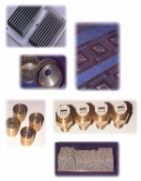SOLUTIONS & SERVICES
Solutions & Services
Bonding Development

Bonding Solutions
S-Bond Technologies offers materials, processing, application development and testing services. Our development staff will work with you and your engineers to provide engineered solutions for your components.We offer a wide range of bonding solutions with active solderng, conventional soldering and brazing protoype services and will work with you to develop production processes.
New developments in bonding technology are continually being investigated in our Development Laboratory, with several such applications outlined below. Contact Us so we can assist you with your applications and developments.
More information and new updates can be found in our Technology & Applications White Paper section and Blog.
S-Bond Alloys
A set of active solder alloys are in regular production and are designed to join over a range of temperatures and for a range of base materials. S-Bond alloys all have the common active elements of Ti, Ce, and/or Ga, which act in combination with many common solder bases, such as Sn-Ag, Sn-In, Sn-Bi and Pb-Sn. These combinations create active solders than can join many metals, ceramics, composites and glasses, wtihout the use of flux.
S-Bond Technologies currently has nine active solder compositions that are being used in various applications. Several have recently been developed and are only available in experimental quantities. S-Bond 220, 220-50, 220M and 400 are our regular production alloys. Our development staff stands by to develop new compositions to meet our customers’ applications requirements.
S-Bond® Alloys | Joining Temp (º C) |
S-Bond 115 (In-Sn) Low temperature for sensitive materials | 125-130oC |
S-Bond 130 (Sn-In) Low temperature for electronics | 140—150oC |
S-Bond 140 (Sn-Bi) Low temperature for ceramics-metals | 150—160oC |
S-Bond 190(Pb-Sn) For hierarchical joining | 200- 210oC |
S-Bond 200 (Sn-Zn) For Pb and Ag free joining, offering lower temperatures that SB-220 | 200—220oC |
S-Bond 220 (Sn-Ag) Most versatile Pb free joining | 240—260oC |
S-Bond 220-50 (Sn-Ag) For joining Al and copper | 240—260oC |
S-Bond 220M (Sn-Ag) For joining glass, ceramics | 240—260oC |
S-Bond 400 (Zn-Al-Ag) Highest temperature active solder | 420—430oC |
Processes
S-Bond joining requires mechanical activation to enable the S-Bond alloys to wet and adhere to the surfaces of the materials being joined. As described in other sections, mechanical activation consists of methods such as brushing, rubbing, or ultrasonics. Once the two surfaces are wetted, joining is achieved by using mechanical activation such as sliding, oscillating and/or rotating.
Components
Solar Panels
S-Bond Technologies has recently been developing methods to join metal conductor strips directly to solar panel surfaces. These conductors collect the photovoltaic (PV) currents created by the impinging solar energy. S-Bond alloys have been developed that directly bond to silicon and other PV materials such as CIGS. Processes using thermo-sonic bonding methods are being developed that will cost effectively be able to directly bond the conductors without the use of flux or plating.
Glass / Metal
S-Bond alloys have been developed that permit the bonding of metals to various glasses. S-Bond 220M was recently developed and patented for its ability to adhere well to glass (Silicates and silicon), refractory metals as well as all other metals. This unique capability for S-Bond’s active solders to bond glass to metal is opening up many oppotunities to replace current glass to metal seals. See our Technology and Applications section for more information.
Ultrasonic Assisted Stud Bonding
The rapid joining of anchor points onto metallic, ceramic and glass joining is a recent area of development that relies on S-Bond Technologies’ bonding expertise in combination with development partners with expertise in ultrasonic metal welding. By employing an innovative combination of heat, vibration, S-Bond filler and pressure, the rapid joining of metallic studs to metal, ceramic and glass surfaces is possible. Applications employing such studs include large, flat aluminum panels for solar collector panels, glass plates for door mounting hardware, medical devices, and many others.
More Information?
If you would like someone to contact you or provide information, please submit the information to the right.
